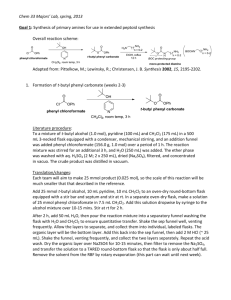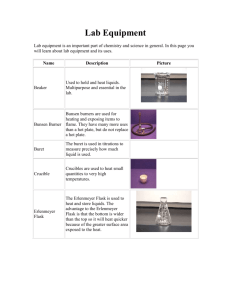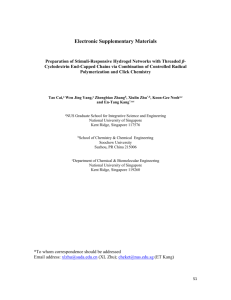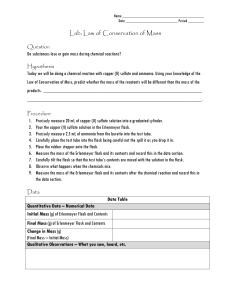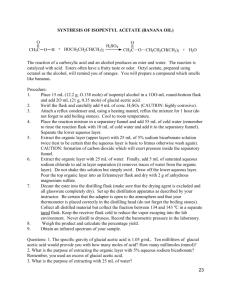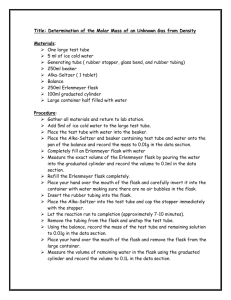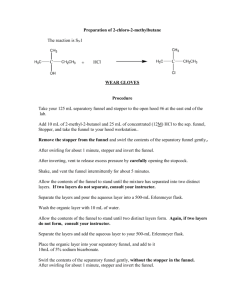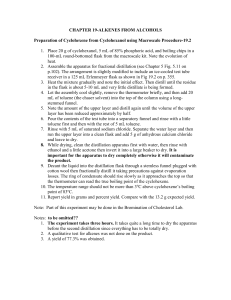Exploration 1
advertisement
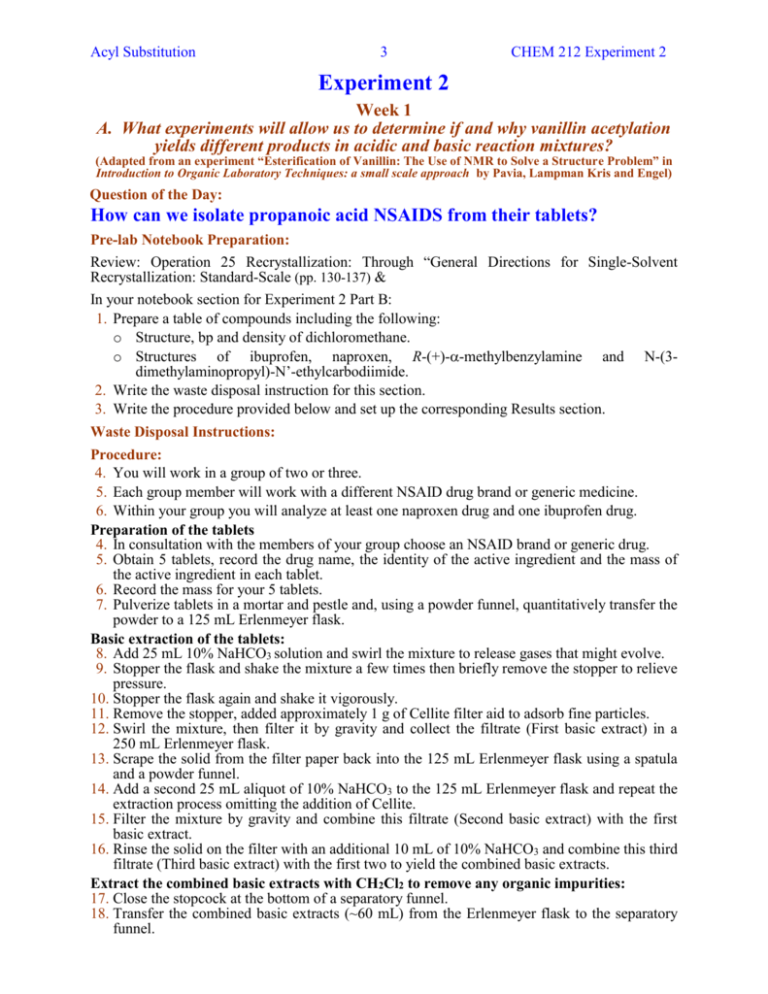
Acyl Substitution 3 CHEM 212 Experiment 2 Experiment 2 Week 1 A. What experiments will allow us to determine if and why vanillin acetylation yields different products in acidic and basic reaction mixtures? (Adapted from an experiment “Esterification of Vanillin: The Use of NMR to Solve a Structure Problem” in Introduction to Organic Laboratory Techniques: a small scale approach by Pavia, Lampman Kris and Engel) Question of the Day: How can we isolate propanoic acid NSAIDS from their tablets? Pre-lab Notebook Preparation: Review: Operation 25 Recrystallization: Through “General Directions for Single-Solvent Recrystallization: Standard-Scale (pp. 130-137) & In your notebook section for Experiment 2 Part B: 1. Prepare a table of compounds including the following: o Structure, bp and density of dichloromethane. o Structures of ibuprofen, naproxen, R-(+)--methylbenzylamine and N-(3dimethylaminopropyl)-N’-ethylcarbodiimide. 2. Write the waste disposal instruction for this section. 3. Write the procedure provided below and set up the corresponding Results section. Waste Disposal Instructions: Procedure: 4. You will work in a group of two or three. 5. Each group member will work with a different NSAID drug brand or generic medicine. 6. Within your group you will analyze at least one naproxen drug and one ibuprofen drug. Preparation of the tablets 4. In consultation with the members of your group choose an NSAID brand or generic drug. 5. Obtain 5 tablets, record the drug name, the identity of the active ingredient and the mass of the active ingredient in each tablet. 6. Record the mass for your 5 tablets. 7. Pulverize tablets in a mortar and pestle and, using a powder funnel, quantitatively transfer the powder to a 125 mL Erlenmeyer flask. Basic extraction of the tablets: 8. Add 25 mL 10% NaHCO3 solution and swirl the mixture to release gases that might evolve. 9. Stopper the flask and shake the mixture a few times then briefly remove the stopper to relieve pressure. 10. Stopper the flask again and shake it vigorously. 11. Remove the stopper, added approximately 1 g of Cellite filter aid to adsorb fine particles. 12. Swirl the mixture, then filter it by gravity and collect the filtrate (First basic extract) in a 250 mL Erlenmeyer flask. 13. Scrape the solid from the filter paper back into the 125 mL Erlenmeyer flask using a spatula and a powder funnel. 14. Add a second 25 mL aliquot of 10% NaHCO3 to the 125 mL Erlenmeyer flask and repeat the extraction process omitting the addition of Cellite. 15. Filter the mixture by gravity and combine this filtrate (Second basic extract) with the first basic extract. 16. Rinse the solid on the filter with an additional 10 mL of 10% NaHCO3 and combine this third filtrate (Third basic extract) with the first two to yield the combined basic extracts. Extract the combined basic extracts with CH2Cl2 to remove any organic impurities: 17. Close the stopcock at the bottom of a separatory funnel. 18. Transfer the combined basic extracts (~60 mL) from the Erlenmeyer flask to the separatory funnel. CHEM 212 Experiment 2 4 Acyl Substitution 19. Add 15 mL of CH2Cl2 to the Erlenmeyer flask and swirl the liquid in the flask to rinse the sides. 20. Pour the CH2Cl2 into the separatory funnel. This should produce two liquid phases in the separatory funnel. 21. Place the stopper in the top of the funnel, invert it and vent any pressure by opening the stopcock. 22. Close the stopcock and shake the mixture gently, venting the pressure a few times until there is little or no pressure release upon venting. 23. Close the stopcock and shake the funnel vigorously to assure intimate mixing of the two liquid phases. 24. Place the funnel in an iron ring, remove the stopper and allow the funnel to stand until the two liquid phases separate cleanly. 25. When the phases are clearly separated, slowly open the stopcock and allow the lower layer to drain into a small beaker. 26. Stop draining when the interface between the two layers just enters the stopcock. 27. Pour the upper layer into a 250 mL beaker. Acyl Substitution 5 CHEM 212 Experiment 2 Acidify the basic aqueous layer. 28. Cool the basic aqueous layer (How is this one chosen?) in an ice bath. 29. Make the solution acidic by slowly adding 6 M HCl and stirring until the solution tests strongly acidic with pH paper. Take care that the solution does not foam over the sides of the beaker. The solution should become cloudy as it becomes acidic (acidified aqueous extracts). Extract the acidified aqueous extracts to collect the neutral NSAID drug: 30. Transfer the acidified aqueous extracts from the beaker to a separatory funnel. 31. Add 30 mL of CH2Cl2 to the beaker and swirl the liquid to rinse the sides of the beaker. 32. Pour the CH2Cl2 into the separatory funnel and extract the acidified aqueous extracts with CH2Cl2 (See instructions above for extraction.) 33. When the phases from the extraction have separated, separate the two layers as before, place the organic CH2Cl2 layer into a 125 mL Erlenmeyer flask. 34. Extract the aqueous layer with another 30 mL portion of CH2Cl2 and combine the second CH2Cl2 layer with the first (Combined CH2Cl2 extracts). This CH2Cl2 layer contains your isolated NSAID drug. Dry (remove water from) the combined CH2Cl2 extracts: 35. Add enough solid anhydrous Na2SO4 to the combined CH2Cl2 extracts to just cover the bottom of the Erlenmeyer flask. 36. Carefully swirl the mixture and observe the behavior of the solid. If there is some solid that floats freely (like snow flakes), then all of the water has been absorbed. If all of the solid sticks in clumps, then add more anhydrous Na2SO4 a small amount at a time until there is some free floating solid. Evaporate the solvent: 37. Decant the “dry” CH2Cl2 into clean, tared 125 mL Erlenmeyer flask, add a boiling chip and clamp the flask in a hot water bath in a hood to evaporate the CH2Cl2 solvent. 38. When there is no longer any visible boiling, detach the clamp from the ring stand and, using it as a handle, carefully tip the flask on its side to pour our any remaining solvent vapor. Take care not to spill any of your recovered drug. 39. Allow the flask to cool, and reweigh it to determine the mass of your recovered NSAID drug. Although NSAIDS are solids, your recovered drug may appear as an oil because of the presence of impurities. TLC Analysis of the recovered NSAID drug: 40. Place a small amount of your recovered drug into your smallest size test tube and add a few drops of CH2Cl2 to dissolve it. 41. Spot your recovered drug and a standard sample of your NSAID on a TLC plate. 42. Develop the plate using the 1:1 mixture of ethyl acetate and hexane available in the hood. (See Chem 211 Experiment 6 for specifics of TLC analysis). 43. Mark the spots on your TLC plate, calculate the Rf’s of all spots, attach the plate to a sheet of paper, label it and place it in your data binder.

